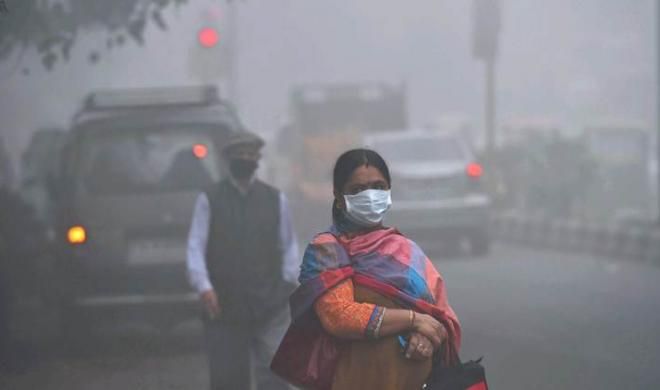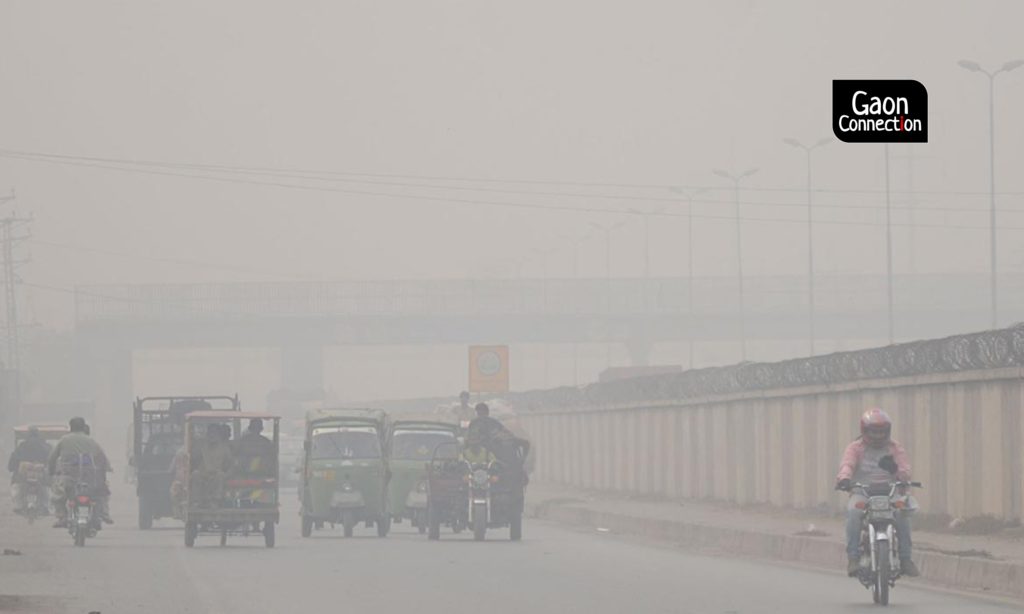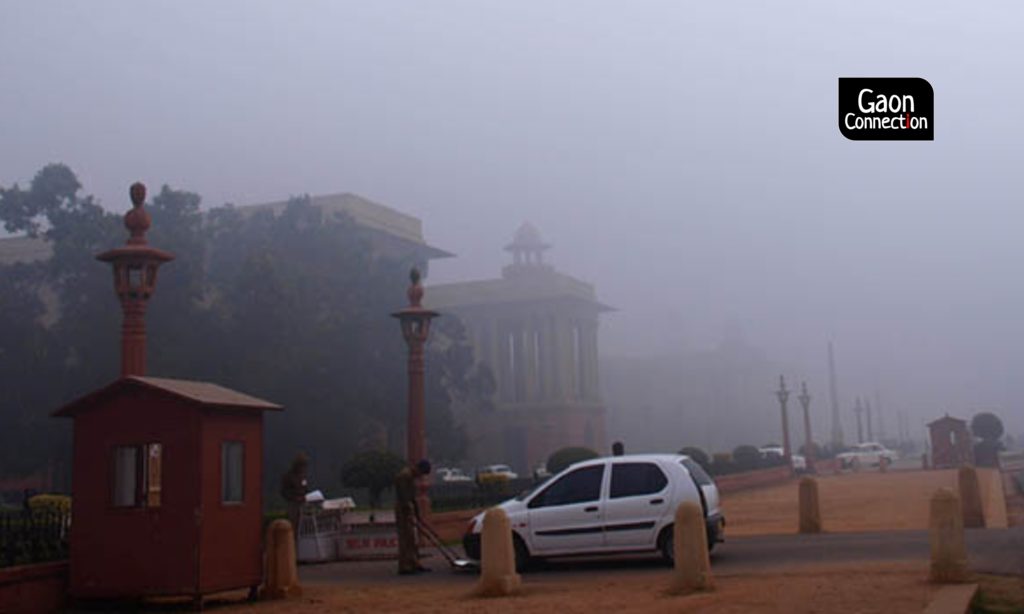Can the Centre’s new ordinance on air pollution clean up NCR-Delhi’s air? Experts’ opinion divided.
Whereas some have welcomed the new commission on air pollution with representatives from different states and ministries, others have termed it a “bureaucratic vessel” or a ‘Civil Servants Club’.


Air quality index (AQI) in Delhi has hit 'severe' category indicating extreme air pollution.
It is the annual déjà vu season when air quality in the National Capital Region (NCR) of Delhi has hit the ‘severe’ category with the onset of winter. Simply put, this means the air in Delhi is extremely toxic and every breath is but a slow poison. Diwali is around the corner and the COVID-19 pandemic is refusing to die out. Stubble burning cases are being reported from Punjab and Haryana where farmers are switching over from paddy crops to preparing their fields for the wheat crop. Fearing worsening air quality and a possible surge in COVID-19 cases, both the government and judicial agencies are getting into action.
Whereas both Odisha and Rajasthan have already issued notifications prohibiting the sale and use of firecrackers in the state till month end, the Chhattisgarh health department has launched a statewide awareness campaign on air pollution and health.
Meanwhile, the National Green Tribunal (NGT) has issued notices to 18 states and Union Territories, where air quality is not satisfactory, to consider taking action (banning firecrackers) like Odisha and Rajasthan have done.
Undoubtedly, air pollution is a national emergency with the NCR-Delhi being one of the most polluted areas in the world. Today morning, it reported an air quality index (AQI) of 508 in ‘severe’ category, the highest category of reporting air pollution.

Last week, on October 28, the Central government issued an ordinance, signed by the President the same night, to set up a commission to address air pollution in NCR-Delhi. This ordinance has replaced the Environment Pollution (Prevention and Control) Authority for the National Capital Region, commonly known as EPCA, which was set up in January 1998, and was so far addressing the air pollution issues in the region.
According to the Central government, the ‘Commission for Air Quality Management in National Capital Region and Adjoining Areas Ordinance, 2020’, as the new ordinance is titled, is meant for “better coordination, research, identification and resolution of problems surrounding the air quality index and for matters connected therewith or incidental thereto”.
It goes on to note that there is “lack of a permanent, dedicated and participative mechanism adopting a collaborative and participatory approach involving the Central Ministries, State Governments, local bodies and other stakeholders to tackle air pollution in the National Capital Region and adjoining areas”. And the new commission is expected to fix this problem.
Through the new ordinance, the government has set up an 18-member commission including a chairperson and secretary as well as eight associate members from different union ministries. The commission will also have representation from five states in the northern region, Central Pollution Control Board, Indian Space Research Organisation, NITI Aayog, pollution experts and non profits. It will co-ordinate with the states of Punjab, Haryana, Rajasthan, Delhi and Uttar Pradesh to plan, execute and monitor programmes for “prevention, control and abatement of air pollution.”
This legislative commission will have “exclusive jurisdiction” in the NCR-Delhi on matters relating to air quality management. It has been provided discretionary authority to search and seize any polluting site and issue a warrant.
For its proper functioning, the commission will have at least three sub-committees — sub-committee on monitoring and identification, sub-committee on safeguarding and enforcement, and sub-committee on research and development. Non-compliance to any of the provisions of the ordinance will attract a fine of up to Rs 1 crore, or imprisonment up to five years. Appeals against the commission’s orders can be made only to the NGT.

The Centre’s new ordinance on air pollution has received a mixed response from sector experts and environmentalists. Whereas some claim an overarching commission was much needed to tackle air pollution in the region through an airshed approach, others allege it is just one more of the multitude of agencies set up by the government to control pollution.
“I welcome the ordinance and the new commission on air pollution because so far the air pollution issue was in the hands of the judiciary, which was giving directions and the executive was following them,” Chandra Bhushan, founder-CEO of International Forum for Environment, Sustainability & Technology (iFOREST), told Gaon Connection. “However, we must remember that at the end of the day, it is the job of the executive to address pollution. It is not the job of the judiciary or judicial body to clean the air or dirty Yamuna. A regional body was much needed to tackle air pollution,” he added.
S N Tripathi, head of the civil engineering department at IIT Kanpur, who is also a member of the steering committee of the Union environment ministry’s National Clean Air Programme (NCAP), has also welcomed the setting up of the commission. “This is a very welcome step and much needed because the key problem was how to coordinate among the states. There was no single body, authority, ministry or state which was empowered or dedicated to do that,” he said.
According to him, the recent ordinance is an excellent example of learning from what the US did in California. “While the US Environment Protection Agency was an autonomous and empowered body set up to manage air pollution across the country, California posed a singular challenge as a hotspot, that’s when the California Air Resource Board was set up to tackle that particular airshed,” he added.
EPCA was limited by having representation only from the NCR, he claimed. The commission, however, was much broader in purview, by bringing in secretary rank members to head it and populating it with officers from the central government, various departments and ministries which represent the polluting sectors, he said.
Similar views are expressed by Tanushree Ganguly, programme associate with New Delhi-based Council for Energy Environment and Water: “Unlike EPCA, which had representatives from Delhi-based institutions and public agencies, the commission will have representatives from all NCR states and relevant departments, and the jurisdiction also goes beyond NCR.” According to her, the three sub-committees of the commission will help delineate responsibility.
However, she also noted that the ordinance only sets up a dedicated authority to curb air pollution in NCR and adjoining areas, but does not outline the sectoral mandates.

Experts agree that the key challenge will emerge during the implementation state. “The major issue with the ordinance will be when it comes to implementation, as EPCA had almost similar powers but failed miserably in cleaning the air even after being in force for more than twenty years,” said Sunil Dahiya, analyst with Centre for Research on Energy and Clean Air, an independent research organisation. “The question of whether it’s a positive move or just a distraction and wasteful exercise will be decided on the fact whether the ordinance changes the status quo when it comes to ground implementation and strict action on polluters or not,” he added.
Meanwhile, there are experts who term the new commission to be a “bureaucratic vessel”. According to Navroz Dubash, professor with Centre for Policy Research, and lead coordinating author, IPCC (The Intergovernmental Panel on Climate Change), air pollution is more than an NCR problem. “The new commission could bring focussed and sustained attention to air quality, and help solve inter-departmental coordination problems. But equally, without clear benchmarks of progress and without ways of devising creative solutions, it could reproduce old deadlocks,” he said.
Dubash went on to add that the commission is a lost opportunity to explicitly set the ground rules for an airshed based approach that could have been deployed in polluted areas across the country. “The lack of clear benchmarks of progress and interim signposts is disappointing. If the commission is to create spaces for more creative solutions, it should send a signal to industries, power plants, farmers, car owners, construction firms and all others that the status quo is no longer tenable,” he said.
He is also critical of the ordinance, which, he claims, “tries to emphasise that the lives of people in other parts of the country are not valued as much as it is for citizens in Delhi-NCR. We have hazardous air pollution situations throughout most of the country and the ordinance fails to address that issue.”
Ritwick Dutta, environmental lawyer and founder of Legal Initiative for Forests and Environment, has called the recent ordinance a “mistake” which is not going to ensure clean air. According to him, “the main purpose of this ordinance is to improve the air quality only in the National Capital Region. Unless the Central Government sets up similar committees in other polluted regions of the country, it violates the right to equality under Article 14 of the Constitution and discriminates against those who are not in the NCR.”
He goes on to call the newly formed commission a ‘Civil Servants Club’. The 15 member permanent body is to be headed by a former secretary to the Government of India or chief secretary to the state government. There is no requirement for any prior experience or expertise in the field of environment in general or air pollution.
According to Dutta, legislation on the environment should not be promulgated through the ordinance route. The principle of participatory democracy requires that there is effective public consultation before enacting any law and regulation. Informed and participatory decision making leads to enactment of legislation which is implementable and is able to achieve its goals, he said.
“There is no doubt that EPCA had long outlived its utility. Unfortunately, it is being replaced by a body which is bureaucratic and has similar limitations as EPCA,” he added.
Bhushan, however, is more hopeful: “What was there was not working, and we need to give the new commission a chance.”
Anumita Roychowdhury, executive director – research and advocacy, and head of the air pollution and clean transportation programme of Centre for Science and Environment, New Delhi, points out that the real challenge for the executive at this crossroad is its preparedness and ability to push for the difficult and inconvenient solutions to reduce particulate pollution by at least 60 per cent.
“The new move brings urgent attention to the public health crisis that it deserves. But clearly, the expectation is that the executive will live up to the new challenge and succeed in implementing the tough solutions needed to clean up the air and the lungs,” she said.

